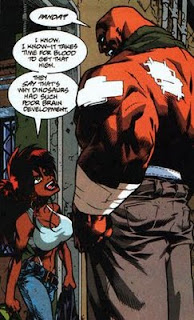Body Bags is a sporadic comic book series that spotlights two characters: the knife-wielding Mack and his 14 year old daughter Panda. They are body baggers, paid bounty hunters / assassins in a futuristic U.S.A. where cybernetic body modifications are available but not necessarily mainstream.
The comic book series was controversial for numerous reason, including -- a main character who seems to have no compunctions about killing others regardless of age, a main character who is underage (14 and a half according to the comic) and is depicted as volumptuous, and gratuitous amounts of (at the time) violence and swearing in a comic book.
Did I like it? I liked it enough to collect the entire initial series, but there was something about the cold-blooded murder by Mack in the opening sequence that really turned me off him. In fact, in order to enjoy the rest of the series I realize now that I deliberately ignored it. Even now, I find that scene extremely distasteful despite the two rationalizations in the comic book concerning the matter.
Anyway, what can we extract from the series for games?
Characters
Distaste over character morality aside, the two main characters are interesting for different reasons.
 |
| Meet Mack and one of his knives. |
Mack is a huge, hulking man who wears an armored T-shirt and armored zippermask with a yellow clown face on it. He also uses two massive knives in combat that seem indestructible and cable of cutting through almost anything and -- it's not really clear how -- he seems strong enough to throw these knives hard enough to match the concussive force of a howitzer.
He's a killing machine, and for powergamers or GMs looking for an interesting recurring villain or on-and-off criminal ally, he certainly fits the bill as dangerous, cruel, and distinctive.
 |
| Not just a tough girl, Panda obviously has a certain way with words. |
It's Panda who steals the show however. Despite the criticisms of her overtly sexual visual representation, I felt that her personality and attitude overpowered her look and appearance. She doesn't have any outward doubts about her capabilities or her self-image, she pushes constantly to get what she wants, and (thankfully) doesn't ever once resort to the stereotypical 'feminine wiles' to achieve her goals.
Like her father, she's quite capable in combat. She apparently has mad skills with guns, and something called "The Eye". There is some pseudo-scientific rationale to this ability, likening it to "the Zone" in sports. It sounds suspiciously like Taskmaster's ability, only less powerful (perhaps because there aren't any true-blue superheroes to copy) but still dangerous enough to supposedly rationalize taking a teenager into combat. Hey, some folks believe that being a circus acrobat from a young age and training them in the martial arts is enough, right?
 |
| Pop culture reference, anyone? |
Furthermore, she reminded me a lot of a foul-mouthed madcap superhero in the vein of Spiderman, Daredevil, the classic Robin, and maybe even the Creeper during her escapades. The only softer side to her is her intent on joining her father in his chosen profession -- and we're smackdab in the middle of controversy again.
Rather than earn a living some other way, her mom -- an officer of the law who died from breast cancer -- sent Panda to live with her dad rather than any other options. At least that's the story Panda tells. Being a body bagger isn't really the best profession for anyone, especially a 14 year old girl.
Because bullets have a tendency to hurt people.
 |
| Attitude and skill don't make you bulletproof, kids. |
Together, Panda and Mack work like Comedian and Straight man in a comedy duo. Mack's always dead serious, while Panda almost never says a line without attitude, a put-down, or a zinger. Their first meeting set the tone for all their future interactions.
 |
| That ain't no way to talk to yer daddy. |
Genre
I'd call it a different take on the cyberpunk genre merged with low-level metahuman abilities. People with money get to become full conversion borgs, while folks like Mack's pre-Panda partner Pops have to get by with low-tech cybernetics just to stave off impending death. And there are folks like Mack who are ridiculously strong and tough, and people like Panda who have "The Eye" (photographic reflexes but not at the level of certain Marvel super-villains).
At the same time, it's firmly in the action genre with a dash of noir -- the difficulties of staying alive and taking care of family when living a criminal lifestyle, the stress of shifting from the grey areas to the black areas of the law, and so on.
And no matter who you are, there's a definite respect for the power of guns and explosions.
GURPS and HERO can handle the rules. I'd think that guns and cybernetics and low-level superpowers would be also managed by a number of other cyberpunk settings in the pool now. Actually, now that I think about it, something like Ghost in the Shell would work as well, just with a lower cybernetics budget.

























